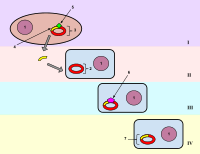
Photo from wikipedia
Ralstonia solanacearum is a soil-borne plant pathogen, responsible of the bacterial wilt disease. Its unusual wide host range (more than 250 plant species), aggressiveness, and broad geographic distribution have made… Click to show full abstract
Ralstonia solanacearum is a soil-borne plant pathogen, responsible of the bacterial wilt disease. Its unusual wide host range (more than 250 plant species), aggressiveness, and broad geographic distribution have made of this bacterium the main plant pathogenic model in the beta-Proteobacteria class. Many R. solanacearum strains have the ability to internalize exogenous DNA through natural transformation. This property is widely used in reverse genetics studies to create mutants or reporter gene constructs, in the aim to study the molecular bases of pathogenesis of this bacterium. In this chapter, we describe three in vitro methods (natural transformation, electrotransformation, and conjugation) commonly used to produce recombinant R. solanacearum cells after introduction of exogenous DNA.
Journal Title: Methods in molecular biology
Year Published: 2018
Link to full text (if available)
Share on Social Media: Sign Up to like & get
recommendations!